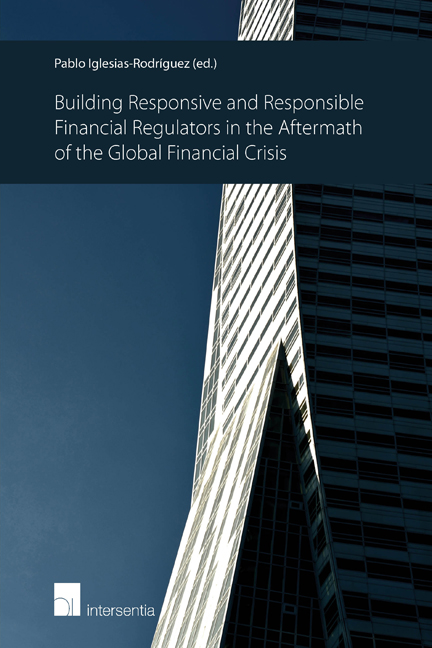Book contents
- Frontmatter
- Preface and acknowledgements
- Foreword
- Contents
- List of contributors
- Responsive-and-responsible financial regulation in the aftermath of the global financial crisis
- Part I THE CONTRIBUTION OF ACCOUNTABILITY, INDEPENDENCE AND ECONOMIC THEORY TO RESPONSIVE-AND-RESPONSIBLE FINANCIAL REGULATION
- Part II POST-CRISIS ARCHITECTURES OF FINANCIAL REGULATION IN THE EUROPEAN UNION, THE UNITED STATES OF AMERICA AND CANADA: ACCOUNTABILITY AND RESPONSIVENESSAND- RESPONSIBILITY
- Part II. 1 THE EUROPEAN UNION
- Part II. 2 THE UNITED STATES OF AMERICA
- Financial stability rearticulated: institutional reform, post-crisis governance and the new regulatory landscape in the United States
- The Financial Industry Regulatory Authority: not self-regulation after all
- Part II. 3 CANADA
Financial stability rearticulated: institutional reform, post-crisis governance and the new regulatory landscape in the United States
from Part II. 2 - THE UNITED STATES OF AMERICA
Published online by Cambridge University Press: 26 November 2017
- Frontmatter
- Preface and acknowledgements
- Foreword
- Contents
- List of contributors
- Responsive-and-responsible financial regulation in the aftermath of the global financial crisis
- Part I THE CONTRIBUTION OF ACCOUNTABILITY, INDEPENDENCE AND ECONOMIC THEORY TO RESPONSIVE-AND-RESPONSIBLE FINANCIAL REGULATION
- Part II POST-CRISIS ARCHITECTURES OF FINANCIAL REGULATION IN THE EUROPEAN UNION, THE UNITED STATES OF AMERICA AND CANADA: ACCOUNTABILITY AND RESPONSIVENESSAND- RESPONSIBILITY
- Part II. 1 THE EUROPEAN UNION
- Part II. 2 THE UNITED STATES OF AMERICA
- Financial stability rearticulated: institutional reform, post-crisis governance and the new regulatory landscape in the United States
- The Financial Industry Regulatory Authority: not self-regulation after all
- Part II. 3 CANADA
Summary
The recent financial crisis was a powerful reminder that the inherent instability of the monetary-financial system is likely to entail serious consequences for the real economy. In the U.S., the monumental Dodd-Frank Wall Street Reform and Consumer Protection Act of 2010 (‘Dodd-Frank Act’) has provided legislation that aims to institutionalise several aspects of a new thinking on financial stability. In addition to the interagency Financial Stability Oversight Council (‘FSOC’), the creation of the Consumer Financial Protection Bureau (‘CFPB’) marks an important departure from the U.S. regulatory tradition of de-centralized agencies whereby the institutional locus of financial oversight depended on the precise nature of the legal structure of and business activities pursued by individual financial intermediaries. In its mandate and institutional structure, the CFPB unifies both ‘micro-prudential’ and ‘macro-prudential’ principles of financial regulation to enhance overall financial stability. From an historical perspective, the creation of the CFPB does not change the regulatory landscape to the same extent as did the creation of the Federal Reserve after the Panic of 1907 or the creation of the FDIC after the 1933 Banking Crisis. At the same time, however, the CFPB represents an important historical shift in the policy focus of U.S. financial regulation away from bank stability to a broad notion of financial stability that recognises the increased financialisation of households’ welfare.
OVERVIEW
The recent financial crisis was a formidable reminder of the inherent instability of the monetary-financial system and of the serious consequences for the real economy that this instability entails. This chapter argues that the broad range of policy responses to the crisis in the United States are unified by a common theme, namely a shift in the policy stance away from monetary stability towards financial stability. On the one hand, this shift is characterised by an extension of the perimeter of financial regulation such that it puts the monitoring of systemic risk on an institutional footing. On the other hand, the U.S. regulatory stance has tilted away from traditional concerns over bank stability towards an institutional recognition that household decision making is increasingly financialised.
The monumental Dodd-Frank Wall Street Reform and Consumer Protection Act of 2010 (‘Dodd-Frank Act’) has provided legislation that aims to institutionalise several aspects that are emblematic of this new thinking on financial stability.
- Type
- Chapter
- Information
- Building Responsive and Responsible Financial Regulators in the Aftermath of the Global Financial Crisis , pp. 215 - 232Publisher: IntersentiaPrint publication year: 2015



